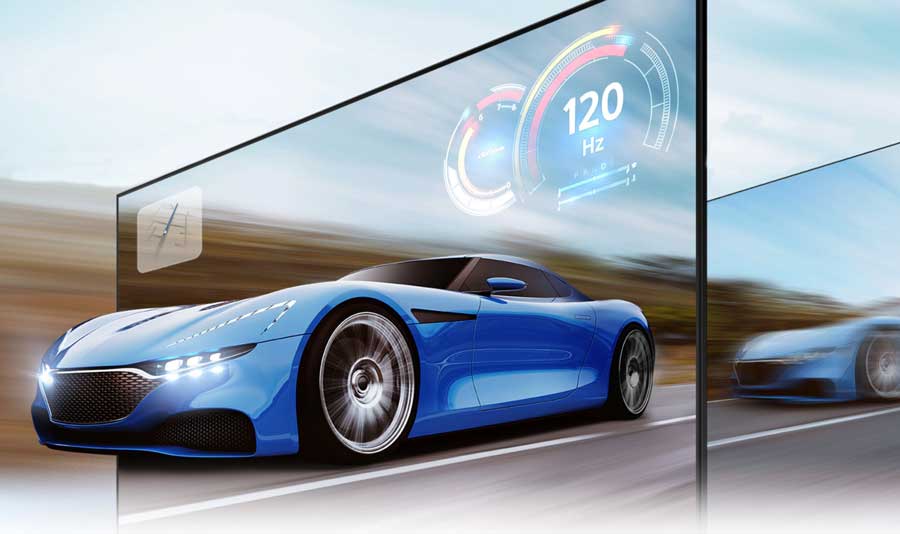Last Updated on June 4, 2023 by Tim Wells
Whether you’re a gamer or streamer, you’ve probably wondered if you should upgrade your older 60Hz TV to a newer 120Hz TV or gaming monitor.
What’s the difference, and is it worth the extra money to get a 120Hz TV or monitor?
In this article, we will talk about the differences between 60Hz vs. 120Hz, and if you should upgrade.
What’s the Difference Between a 60Hz and 120Hz Display?
Hz is an abbreviation for Hertz, which is a frequency unit. When used to describe TVs or monitors, Hz tells you how many times the display refreshes per second.
In short, a 60Hz TV will refresh or re-draw the image on the screen 60 times every second. A 120Hz display will re-draw the image 120 times, and so on.
What’s the Benefit of a Higher Refresh Rate?
OK, so obviously, more is better, right?
Well, yes…to a point.
Higher refresh rates help reduce motion blur.
Have you ever been watching a movie and noticed blurriness or a softer-looking image during a sequence with a lot of action?
That’s motion blur, an issue for most LCD and OLED model screens.
Some people don’t notice motion blur, but it irritates others.
If you are bothered by motion blur or watch a lot of sports or movies with action, upgrading to a 120Hz display is worth it.
Beware Deceptive Marketing Terms When TV Shopping
These days, the TV market is flooded with products with names like Samsung Motion Rate 120 and LG TruMotion 240.
Many shoppers may initially think that the numbers in these model names refer to the TV’s refresh rate, but that’s not the case.
These models use other features to dress up the TV’s actual or “native” refresh rate.
For example, the Samsung Motion Rate 120’s native refresh rate is 60Hz. However, the TV uses frame rate interpolation and black frame insertion to simulate a 120Hz experience.
For more on the difference between a TV’s natural refresh rate and motion rate, TruMotion or MotionFlow, check out my article here.
What is Frame Rate Interpolation?
Also known as motion interpolation or motion-compensated frame interpolation (MCFI), frame rate interpolation helps create a smoother picture and reduces motion blur.
When used with TVs, frame rate interpolation can create the illusion of a higher frame rate.
What Does Black Frame Insertion Do?
Black frame insertion is another method to reduce motion blur in LCD and OLED TVs.
Full-screen black images are inserted between the source’s original frames. During periods with lots of motion, this tricks your brain into seeing the motion as smoother.
The idea for black frame insertion was first proposed in 2006. Still, the technology never became as popular as other motion-blur reduction methods.
That’s because this tactic has some serious flaws. It reduces the picture’s overall brightness by as much as 50% and sometimes causes visible screen flickers.
How Do Refresh Rates and Frame Rates Work?
Refresh rates and frame rates work together.
A frame rate measures how many frames a device can produce per second. These two should always match each other.
For example, if you’re playing a video game that runs at 60FPS (frames per second), you should also have your TV or monitor running at 60Hz. Mismatches can cause motion blur.
Frame rates are much more important for gaming than watching TV or movies. Continue reading to learn more about the benefits of a 120Hz display for gamers.

120Hz TVs and Next-Gen Gaming
In 2020, the release of the PlayStation 5 and Xbox Series X/S consoles sparked new interest in 120Hz TVs and gaming monitors. Both of these next-gen systems feature 4K 120hz.
As any serious gamer knows, fast frame rates are critical to optimizing your hardware’s performance.
Before these next-gen systems, 60Hz was the standard for consoles. And less than a decade ago, 30Hz was considered an adequate performance.
Faster frame mates translate to a smoother gaming experience. You’ll see details you might miss at a lower frame rate. This means you can respond to what you see on the screen faster.
If you’re a serious gamer looking to get the most out of your next-gen console’s hardware, an upgrade to a new 120Hz TV or monitor could be worth the price of admission.
However, it’s important to note that there aren’t all that many console games with 120Hz support on the market as of August 2021. We expect this to become more common, though.
Ideally, you should look for a TV with 120Hz input and a variable refresh rate. These features make for an incredibly smooth gaming experience with minimal choppiness.
Refresh Rates in Gaming Monitors
High refresh rates have been prevalent in PC gaming monitors for years. Today, 120Hz and even 240Hz monitors are common among serious gamers.
Every millisecond matters in competitive PC gaming, so there’s a big difference between 60Hz and 120Hz. Maximizing your frame rate is often necessary for keeping up with your competitors.
There are many other benefits of using a 120Hz or 240Hz monitor, including:
- Motion-blur reduction and sharper images
- Eliminates screen tearing caused by refresh/frame rate mismatches
- Faster input response and less input lag
Competitive gamers will get the most out of a high refresh rate monitor. Still, casual ones will also likely enjoy an improved gaming experience.
If you want to upgrade to a high-end gaming monitor, 120Hz or above should be a priority.
Take your time to find the right option. We recommend making this type of purchase in person to compare your choices first-hand.
Is a 60Hz or 120Hz TV Better For Movies and TV?
High refresh rates have been prevalent in PC gaming monitors for years. Today, 120Hz and even 240Hz monitors are common among serious gamers.
Every millisecond matters in competitive PC gaming, so there’s a big difference between 60Hz and 120Hz. Maximizing your frame rate is often necessary for keeping up with your competitors.
There are many other benefits of using a 120Hz or 240Hz monitor, including:
- Motion-blur reduction and sharper images
- Eliminates screen tearing caused by refresh/frame rate mismatches
- Faster input response and less input lag
Competitive gamers will get the most out of a high refresh rate monitor. Still, casual ones will also likely enjoy an improved gaming experience.
If you want to upgrade to a high-end gaming monitor, 120Hz or above should be a priority.
Take your time to find the right option. We recommend making this type of purchase in person to compare your choices first-hand.
Smartphone Screens: 60Hz vs 90Hz vs 120Hz
Smartphone manufacturers have also started offering high refresh rate smartphones. OnePlus began this trend in 2019 with its 90Hz Oneplus 7 Pro.
Since then, several smartphone manufacturers have introduced 90Hz and 120Hz phones (and even 144Hz), such as:
- Samsung Galaxy S21/S20+ and GalaxyS21 Ultra (120Hz)
- Asus ROG Phone 5 (144Hz)
- OnePlus 9 Pro (120Hz)
- Moto G60 (120Hz)
- Google Pixel 5 (90Hz)
Should I Upgrade to a 120Hz Phone?
It depends on what you’re looking for in a phone. There are pros and cons to 120Hz display smartphones.
You’ll likely notice smoother scrolling and animation effects when using a 120Hz display. Additionally, many users see less eye fatigue during periods of extended use.
However, these benefits sometimes come at the cost of battery life.
There isn’t too much content at 90Hz, let alone 120Hz. This could change in the future, though.
If you’re looking for a new phone and want to future-proof your device, finding an option with a higher refresh rate could be worth it.
Is a 120Hz TV Worth It?
When comparing 60Hz vs. 120Hz, a 120Hz TV is the better choice for video games and watching native 24fps films and other content.
So if you have a 60Hz TV that you’re satisfied with and are not a gamer, an upgrade solely for 120Hz probably isn’t worth it.
However, if you’re in the market for a new TV, most of what you find will be 120Hz anyway. And from now on, we can only imagine 120Hz will become the standard.
Those ready to buy a new 4K TV right now would be wise to go for 120Hz, ensuring your TV stays technologically current for at least several years.
People who are ready to upgrade their TV should focus on other important features too, such as:
- 4K resolution
- HDR compatibility
- OLED vs. LCD Screens
- Several HDMI ports
- Screen size
A new TV is a significant purchase, so taking your time is essential. Shop around, do some research, and find the option that best suits your needs and budget.
FAQ
What is the difference between 60Hz and 120Hz TV?
A 60Hz TV can update to show 60 different frames per second, whereas a 120Hz TV can refresh 120 times per second, doubling the number of times a 60Hz screen can.
Do you need a 120Hz TV for gaming?
A 120Hz TV can be better for gaming if your device supports it, as it can display smoother and more responsive motion for fast-paced games. However, not all devices or games can output 120 frames per second, so you should check the compatibility before buying a 120Hz TV.
How can you tell if a TV is 60Hz or 120Hz?
You can check the specifications of the TV model on the manufacturer’s website or the product label. You should also look for the term “native” or “true” refresh rate, as some TVs may advertise a higher refresh rate that is not actually supported by the panel.
What are the benefits of a 120Hz TV for watching movies?
A 120Hz TV can offer a smoother viewing experience for movies recorded at 24 frames per second, as it can evenly distribute the frames across the screen without introducing judder or stutter. However, some people prefer the cinematic look of a 60Hz TV, as it preserves the film’s original motion.
How does a 120Hz TV affect the soap opera effect?
The soap opera effect is a phenomenon where the motion on the screen looks too smooth and unrealistic as if it was filmed with a video camera instead of a film camera. It is caused by the TV’s motion interpolation feature, which creates extra frames to fill in the gaps between the original frames. A 120Hz TV may enhance this effect by displaying more artificial frames. Still, it can also be turned off or adjusted in the TV’s settings.
- How to Install Kodi Diggz Xenon Plus & Free99 Build [March 2024] - March 3, 2024
- How to Enable Unknown Sources on Chromecast with Google TV [2024] - October 30, 2023
- How to Install the Seren Kodi Addon [2024] - October 29, 2023

